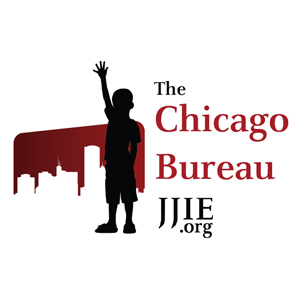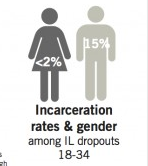
At the age of 12, Q.R. was standing in the principal’s office in nothing but his underwear. With a police officer in the room, the principal found four to five grams of marijuana, drug paraphernalia and a scale in Q.R.’s possession. Q.R. was brought outside the office, handcuffed in front of classmates and arrested for possession and attempt to distribute.Although he was not sentenced to a juvenile detention center, he was put on probation from school and mandated to do community service hours.
Born in Rogers Park, a Far North Side Chicago neighborhood, Q.R., whose identity was verified by The Chicago Bureau but is being kept confidential due to his past involvement with drugs, is the son of a first-generation immigrant – his father is from Guatemala. At the age of three, after his parents got divorced and his father moved back to Guatemala, he moved with his mother and siblings to DeKalb, Illinois.
Q.R.’s experience highlights some challenges associated with assimilation and acculturation that second generation immigrants face across the country, as a recent study published in the Journal of Youth and Adolescence shows.
 The study by Bianca Bersani, Thomas Loughran and Alex Piquero, titled “Comparing Patterns and Predictors of Immigrant Offending Among a Sample of Adjudicated Youth,” concluded that second generation immigrants are not only more likely to commit crime than first generation immigrants, but also adopt “counterproductive behaviors that are common to American life” such as smoking, drinking and high-calorie diets.
The study by Bianca Bersani, Thomas Loughran and Alex Piquero, titled “Comparing Patterns and Predictors of Immigrant Offending Among a Sample of Adjudicated Youth,” concluded that second generation immigrants are not only more likely to commit crime than first generation immigrants, but also adopt “counterproductive behaviors that are common to American life” such as smoking, drinking and high-calorie diets.
“Native-born Americans commit crime just as much as immigrants commit crime,” Piquero said in an interview with The Chicago Bureau. “In fact, the crime problem in America is not an immigration problem or an immigrant problem. The crime problem in America is an American problem and that’s what our analyses really show.”

- Graphic courtesy of Project NIA, showing the tough path facing minors who dropout of school or work and the high racial disparity among those arrested.
Still, using a sample of high-risk adjudicated youth, the authors found that assimilation and disadvantage, which was measured by neighborhood conditions, were key factors in influencing offending rates. However, the authors were unable to discern the exact ways in which assimilation and disadvantage explain patterns of offending.
“It’s not a common story for Americans to hear that it isn’t necessarily the first generation immigrants over the border that are crime producers,” said Tracy Siska, executive director of the Chicago Justice Project. “It really has a lot more to do with America then it has to do with them as immigrants.”
Arthur Lurigio, a professor of psychology and criminal justice at Loyola University Chicago, calls it the immigrant paradox.
It might be expected by many Americans that first-generation immigrants are more likely to engage in illegal behavior – considering their often down-and-out status, desperate for work, pay and a place to call home. Yet in fact the risk-takers are American-born, children of immigrants, who do not have to fear deportation. That, together with the burden of cultural assimilation, can drive bi-cultural youth to seek belonging in peer groups, for better or worse.
“They’re caught between two cultures and they are prone to influences that have a delinquent or criminal past to them because they very much want to belong in a group, but they don’t quite fit,” Lurigio said. “At home, it’s Mexico. In school, it’s the United States. In the street, it’s a combination thereof, but it’s mostly American culture that predominates and so many of these young men in particular seek their affiliation through membership in street gangs.”
For Q.R., gangs were the norm. With a mother that worked full-time at a hospice care center and attended night school to become a registered nurse, he said he and his siblings got little maternal attention and guidance.
“The only role models that we had, which were the oldest boys in the neighborhood, most of them either belonged to one of two Latin street gangs–the Latin Kings or Ambrose,” he said.
Balancing two languages and two cultures, Q.R. said he struggled to find his identity.
“I think my biggest challenge was figuring out where I fit in and how, because most of the time I didn’t – I didn’t fit in,” he said. “I was a light skin boy with blond hair speaking Spanish with a Native American name.”
He added, “I feel like the culture that we grew up in, that we knew, we developed on the streets.”
Adam Efren Lopez, a graduate student at Northern Illinois University and a coordinator at VALU, an afterschool program in DeKalb that aims to help Latino youth feel more included and productive, has also struggled to define his identity. Although Lopez’s father was born in Mexico, he immigrated with his family to Mission, Texas when he was 12. Lopez’s mother was born in the United States and also raised in Mission, a town right on the border. Lopez considers himself a second generation immigrant and identifies as Chicano.
“It’s something I identify with because I’m not really in either of a place, but yet I’m still something that’s different,” he said. “Especially here (at Northern Illinois University)…there’s not many Latinos around. I’m one out of very few.”
According to NIU’s website, 13.2 percent of the student population identifies as Hispanic or Latino.
Tomas Ramirez, founder of Infinite Conversations, a consulting firm based in the Brighton Park neighborhood of Chicago that focuses on community building and restorative justice, said immigrant families’ loss of culture results in pressure to establish a new sense of identity through whatever means possible.
“The more that you disconnect, the more likely that you’re going to get yourself involved in activities that might not be good for you or with company that also may not be the best for you because you’re looking for an identity, you’re looking to define a place for you in society,” he said. “We’re in a society that still does not embrace those who are different in our society.”
He added that this loss of culture sometimes stems from changing priorities. As immigrant families struggle to stand firm in new environments, the need to preserve tradition for younger generations can fall to the wayside.
“For example,” Ramirez said, “it’s more important to pay rent and put food on the table then to celebrate the traditional customs from the town you are coming from.”
Additionally, schools can be a direct source of hardship for second generation immigrant children.
“Many of them struggle with the language because they’re are bilingual and usually in improvised neighborhoods in which the school systems are inadequate and subpar . . . they’re not doing well in school and that puts them at risk for delinquency, whereas those kind of factors did not affect their parents,” Lurigio said.
Lopez said the high dropout rate among Latinos in particular is a side effect of American schools’ Eurocentric curricula. According to data published by the Chicago Public Schools, the Latino dropout rate in 2013 for a five-year cohort was 25.1 percent.
“In my opinion, that has a lot to do with (whether) they see themselves in the curriculum. When you don’t even know your own culture really outside of whatever the TV . . . shows you, it’s very, very hard to really understand your identity and your culture,” he said.
For Q.R., his life course changed completely at the age of 16 when he participated in a sweat lodge ceremony hosted by Youth Struggling for Survival, a youth empowerment organization. At 18, his criminal record was cleared, which was worked out by his probation office and the judge after he completed the court services.
With an expunged record, Q.R. is now finishing his last semester of college studying marketing, business administration and Spanish. He plans to apply to be a member of the Peace Corps.
“With that new organization, I was able to attain role models that were invested in me, other men who I felt cared about me and seeing me succeed,” he said. “Since then, I have been able to share that interest with other youth.”
